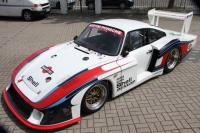935 'Moby Dick'
 Construction:
Construction:
Of all the competition variants of the 911, only a few can be considered true “prototypes” and none more so than Moby Dick. Born from an imaginative reading of the rules as interpreted by Norbert Singer for the 1978 season. The few pieces of production sheet metal that surrounded the alloy chassis served only to identify Moby Dick as a member of the 911 family.
A number of new components were developed for the 935/78 as the car was officially known on the books and called Moby Dick by almost everyone else in the motorsport fraternity. Larger one piece aluminum brake calipers replaced the three piece type as did an overall larger brake disc, a new housing known as the “upside down” gearbox were to later be used on the customer versions of the standard 935. The special body with advanced aerodynamics had a drag coefficent that favored comparably with the longtail 917’s that competed at Le Mans in 1970 and 1971.
The most special part of Moby Dick is what powered the car. The 3.2 liter four valve, twin cam water cooled Type 935/71 six cylinder turbo capable of running 1.7 bar boost at revs as high as 9000 RPM. None of these motors were ever made available to private teams.
Moby Dick chassis number 935-006 competed in four events in 1978. It easily won the Silverstone 6 hour race, quailified on the second row at the 24 Heures du Mans, ahead of many supposedly faster Group 6 prototypes, although being at the top of the charts on speed, 935-006 suffered a series of problems that resulted in a finish of 8th overall. At the 6 Hours of Vallelunga, 935-006 easily lead and was seven minutes from taking the flag when an injection pump belt broke. The final race for 935-006 was at Norisring and early retirement was caused by a brake balance bar. The results may not have been satisfactory, however, it showed the tremendous potential of such a car.
A new Moby Dick chassis had been produced by Weissach to be used for the 1979 season. This was to be the last werks team 935 to ever be constructed, 935-007. Unfortunately the program was cancelled and the partnership between Martini and Porsche came to a close. The new chassis, 935-007, would have retained the basic overall appearance of the previous car, however, Norbert Singer was in the process of developing more efficient ground effects for the bodywork.
After the 1978 season, 935-006 went to the Porsche Museum, never to race again. Without a program for 1979, the new chassis 935-007 was put in storage at Korntal where it remained until September of 1988 when it was sold to Kerry Morse of Irvine, California. For almost four years, Morse had been trying to purchase 935-007 and he finally succeeded in getting it released from the racing dept. and over to the customer sport dept. so it could be purchased. Morse watched as 935-007 was put in a wooden crate at Korntal and accompanied the big box to the airport where it was shipped to Los Angeles.
935-007 remained in the crate at the shop of Kerry Morse while he attempted to gather as many parts for the car as possible. This was a difficult task as so many of the parts for Moby Dick were unique. Reinhold Joest had built two replicas of Moby Dick, using the drawings as supplied by the factory, however with the exception of some of the bodywork, the Joest built cars were heavily compromised. They used the standard air cooled 935 motor and did not have the extra coolers, lines and special brackets for the water cooled four valve motor. Morse was adamant that 935-007 would have the correct 3.2 if it was to ever be completed.
Twenty years later, Kerry Morse sold 935-007 to Manfred Freisinger, Jr. and the project of assembling the last prototype 935 finally began in earnest. Freisinger was quick to start locating parts that had been stored away and forgotten. A new old stock set of rear bodywork that had been made for Joest. one of the spare 3.2 liter four valve motors from 935-006 in addition to the correct gearbox. New molds were made from a damaged front nose that was located in California. Kerry Morse supplied an original new fuel cell that he found at a storage facility at Weissach. Freisinger was fortunate that he already had the special brakes as his father had purchased a large lot of race parts from Porsche and at the time, it was unknown as to what car they had been produced for. Many of the suspension components were already on hand.
Careful research was done in the choice of the correct colors for the Martini colors as Moby Dick differed slightly from the other Martini livered race cars of the time. The results are here to see and there will be every attempt of Manfred Freisinger to compete with 935-007 at many of the classic historic race meetings.











